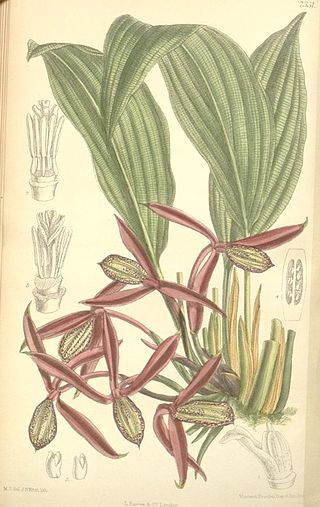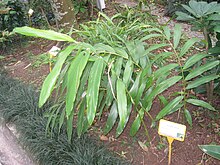
Zingiberaceae or the ginger family is a family of flowering plants made up of about 50 genera with a total of about 1600 known species of aromatic perennial herbs with creeping horizontal or tuberous rhizomes distributed throughout tropical Africa, Asia, and the Americas. Many of the family's species are important ornamental, spice, or medicinal plants. Ornamental genera include the shell gingers (Alpinia), Siam or summer tulip, Globba, ginger lily (Hedychium), Kaempferia, torch-ginger Etlingera elatior, Renealmia, and ginger (Zingiber). Spices include ginger (Zingiber), galangal or Thai ginger, melegueta pepper, myoga, korarima, turmeric (Curcuma), and cardamom.

Alpinia is a genus of flowering plants in the ginger family, Zingiberaceae. Species are native to Asia, Australia, and the Pacific Islands, where they occur in tropical and subtropical climates. Several species are cultivated as ornamental plants.

Elettaria is a genus of flowering plants in the family Zingiberaceae. They are native to India and Sri Lanka, but cultivated and naturalized elsewhere. One member of the genus, E. cardamomum, is a commercially important spice used as a flavouring agent in many countries.

Zingiber is a genus of flowering plants in the family Zingiberaceae. It is native to Southeast Asia, especially in Thailand, China, the Indian Subcontinent, and New Guinea. It contains the true gingers, plants grown the world over for their culinary value. The most well known species are Z. officinale and Z. mioga, two garden gingers.

Orchidantha is a genus of flowering plants. In the APG III system, it is placed in the family Lowiaceae, as the sole genus. It includes the plants in the formerly recognised genera Lowia and Protamomum.

Curcuma is a genus of plants in the family Zingiberaceae that contains such species as turmeric and Siam tulip. They are native to Southeast Asia, southern China, the Indian Subcontinent, New Guinea and northern Australia. Some species are reportedly naturalized in other warm parts of the world such as tropical Africa, Central America, Florida, and various islands of the Pacific, Indian and Atlantic Oceans. Generally, most curcuma grows well in loose and sandy soil in shaded areas.
Riedelia is a genus of plants in the family Zingiberaceae. The genus contains approximately 75 species that are distributed among New Guinea, the Solomon Islands, and Maluku Province in eastern Indonesia. Among the described species is Riedelia charontis, which was formally described in 2010.
Meistera is an Asian genus of plants in the family Zingiberaceae. Species have been recorded from Tropical & Subtropical Asia to northern Queensland.
Conamomum is a genus of flowering plants in the family Zingiberaceae and tribe Alpinieae. Its native range is from Indochina to western Malesia.

Hornstedtia is a genus of plants in the Zingiberaceae. It is native to Southeast Asia, the Himalayas, southern China, New Guinea, Melanesia and Queensland.

Plagiostachys is a genus of plants in the Zingiberaceae. It is native to Southeast Asia.

Boesenbergia is a genus of plants in the ginger family. It contains more than 90 species, native to China, the Indian Subcontinent, and Southeast Asia.
Wurfbainia elegans is a species of plant belonging to Zingiberaceae, the ginger family. It is endemic to the Philippines.
Wurfbainia uliginosa is the type species of the recently reconstituted plant genus Wurfbainia in the ginger family. Its native range is from Indo-China to Sumatra.
Sulettaria is a genus of flowering plants in the family Zingiberaceae. The species of the genus were formerly placed in the genus Elettaria until 2018.
Wurfbainia vera is a herbaceous plant in the Zingiberaceae family. Formerly called Amomum verum, it was the first plant species to be named by a woman, the Scots artist Elizabeth Blackwell in 1757. The Kingdom of Siam obtained the fruit (seeds) of the plant from Cambodia in the 18th century to export as a spice to China and Europe. The species occurs not only in Cambodia, but also in Sumatra, Thailand and Vietnam. The young leaf, the fruit and the seeds are edible, the seeds are known as Siam cardamom in English.
Epiamomum is a genus of plants in the family Zingiberaceae and tribe Alpinieae; all records to date are from Borneo island. Before 2018, some species were placed in the genus Amomum.
Sundamomum is a genus of flowering plants belonging to the family Zingiberaceae.
Newmania is a genus of rhizomatous based flowering plants belonging to the family Zingiberaceae. They are only native to Vietnam, and found in forests.









